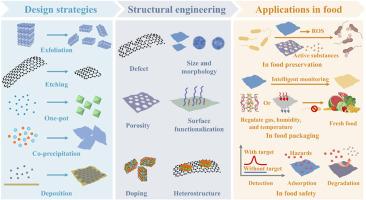Advances in emerging two-dimensional nanomaterials: Design strategies, structural engineering, and applications in food
IF 15.4
1区 农林科学
Q1 FOOD SCIENCE & TECHNOLOGY
引用次数: 0
Abstract
Background
Food quality and safety issues have garnered extensive attention globally, making it essential to adopt effective ways to avoid such problems. Emerging two-dimensional nanomaterials (2DNMs) have demonstrated exceptional potential in advancing food quality and safety due to their unique physicochemical properties and versatile functionalities. Over the past decade, significant breakthroughs have been achieved in leveraging 2DNMs for applications in the food industry.
Scope and approach
This review provides a comprehensive overview of recent progress of 2DNMs in the food industry. Classical synthesis techniques and critical structural features are systematically explored. Special attention is given to the mechanisms underlying their roles in food preservation, intelligent packaging, and safety enhancement. Finally, the review concludes by highlighting future perspectives and challenges. This review not only provides theoretical insights for optimizing high-performance 2DNMs but also presents new avenues for inventive development in the food industry.
Key findings and conclusions
2DNMs exhibit unique layered structures, large specific surface areas, and tunable physicochemical properties, which confer significant advantages for various food applications. The fabrication techniques for 2DNMs are diverse, ranging from simple and efficient co-precipitation to high-precision etching strategies and low-cost, multifunctional one-pot methods. Through structural adjustments (such as defect control, pore structure, surface modification, etc.), 2DNMs exhibit enhanced multiple functions such as catalytic, electronic, and adsorption. 2DNMs can enhance food quality and safety through antimicrobial action, encapsulation of natural active substances, regulation of gases, intelligent monitoring, management of temperature and humidity, and the removal of hazardous substances, providing novel perspectives to advance this field.

新兴二维纳米材料的进展:设计策略、结构工程和在食品中的应用
食品质量和安全问题在全球范围内引起了广泛关注,因此采取有效的方法来避免这类问题至关重要。新兴的二维纳米材料(2dnm)由于其独特的物理化学性质和多功能,在提高食品质量和安全方面表现出了非凡的潜力。在过去的十年中,利用2dnm在食品工业中的应用取得了重大突破。本文综述了2dnm在食品工业中的最新进展。系统地探讨了经典合成技术和关键结构特征。特别关注其在食品保存,智能包装和安全性增强中的作用机制。最后,总结了未来的展望和挑战。该综述不仅为优化高性能2dnm提供了理论见解,而且为食品工业的创新发展提供了新的途径。2dnm具有独特的层状结构、较大的比表面积和可调的物理化学性质,在各种食品应用中具有显著的优势。2dnm的制造技术多种多样,从简单高效的共沉淀法到高精度的蚀刻策略和低成本、多功能的一锅法。通过结构调整(如缺陷控制、孔结构、表面修饰等),2dnm表现出增强的催化、电子、吸附等多种功能。2dnm可以通过抗菌作用、天然活性物质的封装、气体调节、智能监控、温湿度管理、有害物质去除等方式提高食品质量和安全,为该领域的发展提供了新的视角。
本文章由计算机程序翻译,如有差异,请以英文原文为准。
求助全文
约1分钟内获得全文
求助全文
来源期刊

Trends in Food Science & Technology
工程技术-食品科技
CiteScore
32.50
自引率
2.60%
发文量
322
审稿时长
37 days
期刊介绍:
Trends in Food Science & Technology is a prestigious international journal that specializes in peer-reviewed articles covering the latest advancements in technology, food science, and human nutrition. It serves as a bridge between specialized primary journals and general trade magazines, providing readable and scientifically rigorous reviews and commentaries on current research developments and their potential applications in the food industry.
Unlike traditional journals, Trends in Food Science & Technology does not publish original research papers. Instead, it focuses on critical and comprehensive reviews to offer valuable insights for professionals in the field. By bringing together cutting-edge research and industry applications, this journal plays a vital role in disseminating knowledge and facilitating advancements in the food science and technology sector.
 求助内容:
求助内容: 应助结果提醒方式:
应助结果提醒方式:


